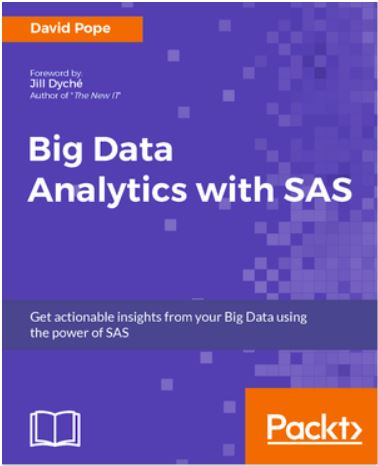There are so many reasons why SAS programmers love SAS -- as a matter of fact, I wrote a blog on it back in 2012. I now realize that I could've written a whole series, not just a single post. And with the recent publishing of my first book, Big Data Analytics with SAS, which includes a whole chapter on the subject, I figured it was time to revisit the topic and share some more love! Here's one example from the book:
 "... a colleague of mine, Lisa Dodson, explains one reason this way. 'Many SAS users will talk about how much they like SAS because it makes it easy for them to work with any data. What does that really mean? Well, if you dive a bit deeper into this statement, it points to SAS' data access capabilities, which free the end user from having to know what data types from different data sources are.'
"... a colleague of mine, Lisa Dodson, explains one reason this way. 'Many SAS users will talk about how much they like SAS because it makes it easy for them to work with any data. What does that really mean? Well, if you dive a bit deeper into this statement, it points to SAS' data access capabilities, which free the end user from having to know what data types from different data sources are.'
In other words SAS' access layer auto-magically takes care of translating data types to and from the SAS environment. This is just one example of the power of SAS' data management capabilities that makes SAS programmers love SAS."
Other examples in the book highlight the fact that you don't always have to manually code to love SAS programming because there are several easy-to-use graphical user interfaces (GUIs), allowing you to tap into the power of SAS with no manual coding. Instead, you just point-and-click or drag-and- drop. Here are a few of the SAS offerings with GUIs that SAS programmers love to use:
- SAS® Enterprise Guide®
- SAS® Studio
- SAS® Visual Analytics
- SAS® Enterprise Miner™
- SAS® Visual Data Mining and Machine Learning
Check out the book for more examples, and add your own favorite reasons you love SAS programming in the comments below.

4 Comments
Love to lose is right haha... I would never let one of my analysts use any GUI.
Cool post.
Richard,
Thanks for catching the typo. BTW I find your statement about not allowing your analysts to use a GUI interesting.
Why wouldn't you want to have someone use a GUI that could help them do more in less time AND still be able to get
into the code if/when needed?
David
Honestly, I haven't had any experience with SAS GUIs -- we only do code in SAS -- but in other contexts (ArcGIS, Stata, etc) it can be a replicability nightmare if people use point-and-click to produce some result. I would rather have people take the time to write me some clean code.
Richard,
Thanks for replying back to me. Being a programmer and a SAS programmer I understand where you are coming from when using other GUIs.
Many of the SAS GUIs actually auto-generate the code behind the scenes for you so that you can use it as a basis to get a quick start an your objective. Think of them as
a productivity tool that saves an experienced programmer/analyst time on "regular" coding so more time can be spent deriving insights and writing more complex analysis.
As a matter of fact the newest solutions from SAS like SAS Visual Data Mining and Machine Learning provide by design 2 ways to use the solution: by GUI and by a programming interface.
This is meant to allow different levels of analysts the ability be productive a provide a path for learning more beyond what the GUI allows.
Regards,
David